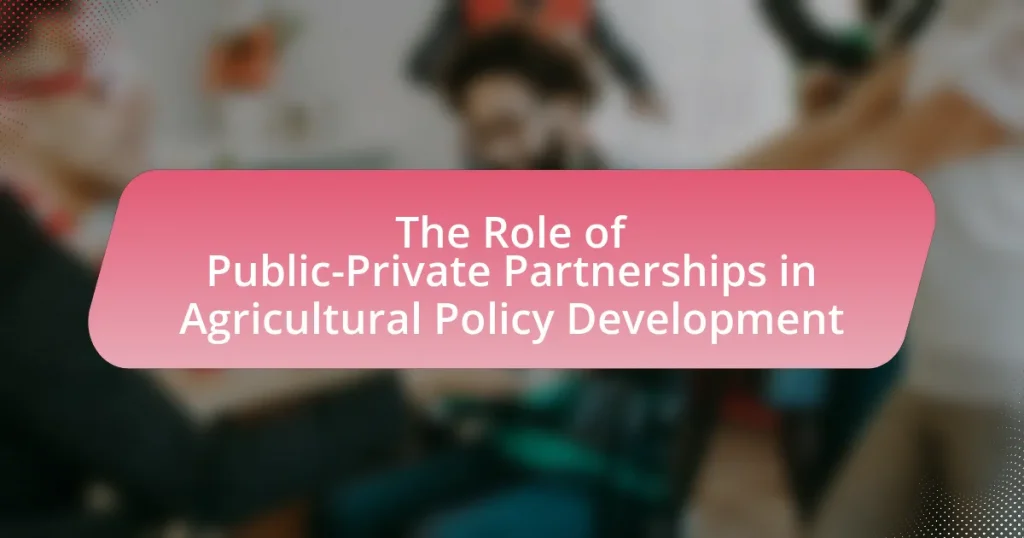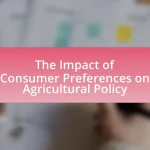Public-Private Partnerships (PPPs) play a crucial role in agricultural policy development by fostering collaboration between government entities and private sector organizations to enhance agricultural productivity and sustainability. This article outlines how PPPs function within the agricultural sector, highlighting key components such as collaboration, risk-sharing, investment, and innovation. It also addresses the challenges faced by these partnerships, including misalignment of objectives and regulatory hurdles, while providing best practices for effective implementation. Furthermore, the article examines successful case studies and practical strategies to improve stakeholder engagement and communication, ultimately demonstrating the significant impact of PPPs on food security and economic growth in agriculture.
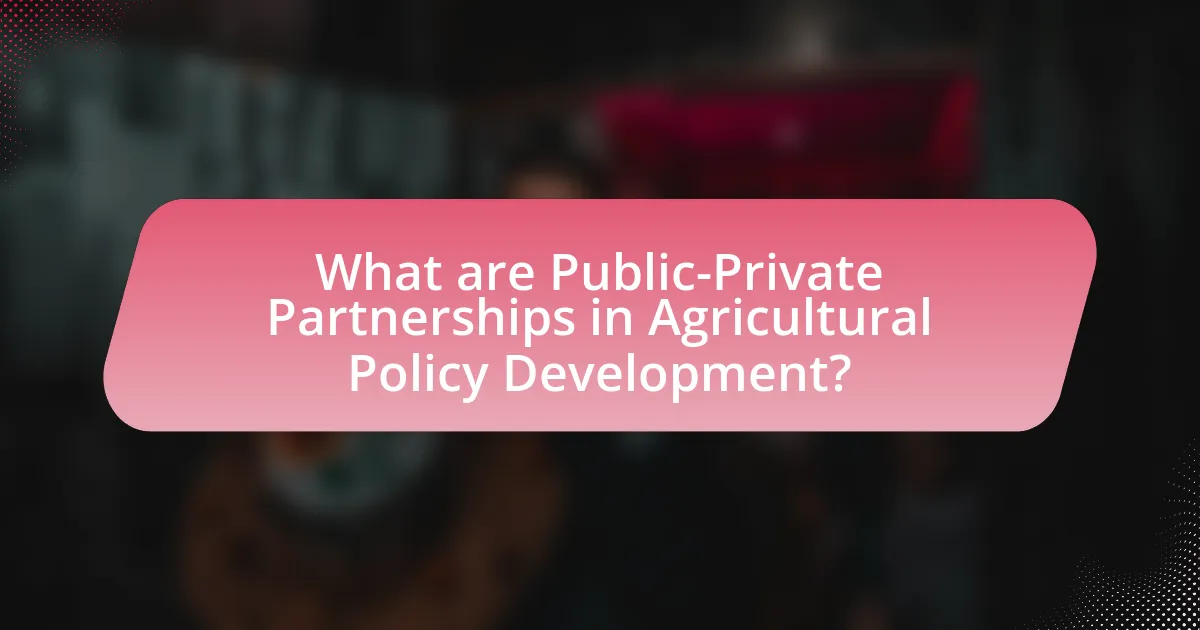
What are Public-Private Partnerships in Agricultural Policy Development?
Public-Private Partnerships (PPPs) in agricultural policy development are collaborative agreements between government entities and private sector organizations aimed at enhancing agricultural productivity and sustainability. These partnerships leverage the strengths of both sectors, where public entities provide regulatory frameworks and funding, while private organizations contribute expertise, innovation, and efficiency. For instance, the Food and Agriculture Organization (FAO) has highlighted successful PPPs that have improved food security and rural development by combining resources and knowledge from both sectors.
How do Public-Private Partnerships function in the agricultural sector?
Public-Private Partnerships (PPPs) in the agricultural sector function by facilitating collaboration between government entities and private companies to enhance agricultural productivity and sustainability. These partnerships leverage public resources and private sector expertise to implement projects such as infrastructure development, research and innovation, and technology transfer. For instance, the World Bank has reported that PPPs can improve access to markets and finance for farmers, leading to increased agricultural output and income. Additionally, successful PPPs often involve shared risks and benefits, ensuring that both parties contribute to and gain from the partnership, which has been evidenced in various agricultural initiatives across countries like India and Brazil.
What are the key components of Public-Private Partnerships in agriculture?
The key components of Public-Private Partnerships (PPPs) in agriculture include collaboration, risk-sharing, investment, and innovation. Collaboration involves joint efforts between public entities and private sector stakeholders to achieve common agricultural goals. Risk-sharing allows both parties to distribute the financial and operational risks associated with agricultural projects, enhancing sustainability. Investment refers to the financial contributions made by both sectors to fund agricultural initiatives, which can lead to improved infrastructure and technology. Innovation is driven by the private sector’s expertise and resources, fostering advancements in agricultural practices and productivity. These components collectively enhance agricultural policy development and implementation, as evidenced by successful PPP models in various countries that have led to increased food security and economic growth.
How do these components interact to influence agricultural policy?
Public-private partnerships (PPPs) interact by combining resources, expertise, and objectives from both sectors to influence agricultural policy. These collaborations enable the public sector to leverage private sector innovation and efficiency, while the private sector gains access to public resources and regulatory frameworks. For instance, a study by the World Bank highlights that PPPs can enhance agricultural productivity by facilitating technology transfer and improving infrastructure, which directly impacts policy decisions aimed at food security and rural development. This synergy fosters a more responsive policy environment that addresses the needs of farmers and consumers alike, ultimately shaping the direction of agricultural policy.
Why are Public-Private Partnerships important for agricultural policy development?
Public-Private Partnerships (PPPs) are important for agricultural policy development because they leverage resources, expertise, and innovation from both sectors to enhance agricultural productivity and sustainability. By combining public sector regulatory frameworks and funding with private sector efficiency and technological advancements, PPPs facilitate the implementation of effective agricultural policies. For instance, a study by the World Bank highlights that PPPs can improve access to markets and finance for farmers, leading to increased agricultural output and income. This collaborative approach ensures that policies are not only well-informed but also practical and adaptable to the needs of the agricultural community.
What benefits do Public-Private Partnerships provide to agricultural stakeholders?
Public-Private Partnerships (PPPs) provide agricultural stakeholders with enhanced access to resources, improved infrastructure, and increased innovation. These partnerships facilitate investment from the private sector, which can lead to the development of better technologies and practices in agriculture. For instance, a study by the World Bank indicates that PPPs can improve agricultural productivity by up to 30% through shared expertise and resources. Additionally, PPPs often lead to better risk management strategies, allowing stakeholders to navigate market fluctuations more effectively. This collaborative approach not only boosts efficiency but also fosters sustainable agricultural practices, ultimately benefiting food security and economic growth in the sector.
How do Public-Private Partnerships enhance innovation in agriculture?
Public-Private Partnerships (PPPs) enhance innovation in agriculture by facilitating collaboration between government entities and private sector companies, leading to the development and implementation of advanced agricultural technologies and practices. These partnerships leverage the strengths of both sectors; public entities provide regulatory support and funding, while private companies contribute expertise, research capabilities, and market access. For instance, a study by the Food and Agriculture Organization (FAO) highlights that PPPs have successfully introduced precision agriculture technologies, which improve crop yields and resource efficiency, demonstrating the tangible benefits of such collaborations.
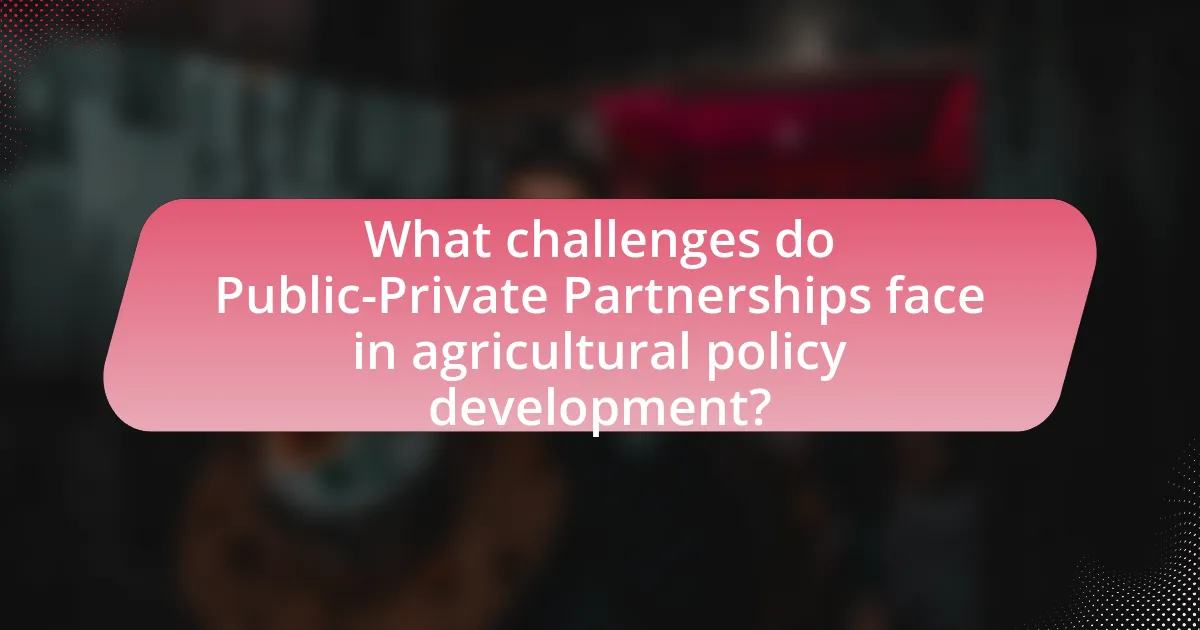
What challenges do Public-Private Partnerships face in agricultural policy development?
Public-Private Partnerships (PPPs) in agricultural policy development face several challenges, including misalignment of objectives, regulatory hurdles, and funding constraints. Misalignment occurs when public and private entities have differing goals, which can lead to conflicts and inefficiencies in project execution. Regulatory hurdles often arise from complex legal frameworks that can hinder the swift implementation of initiatives. Additionally, funding constraints limit the ability of PPPs to invest in necessary infrastructure and technology, impacting the overall effectiveness of agricultural policies. These challenges are documented in various studies, such as the World Bank’s report on PPPs in agriculture, which highlights the importance of clear communication and aligned interests for successful collaboration.
What are the common obstacles to successful Public-Private Partnerships?
Common obstacles to successful Public-Private Partnerships (PPPs) include misalignment of goals, lack of trust, inadequate risk-sharing mechanisms, and insufficient stakeholder engagement. Misalignment of goals occurs when public and private entities have differing priorities, which can hinder collaboration. Lack of trust between partners can lead to communication breakdowns and reluctance to share critical information. Inadequate risk-sharing mechanisms can result in one party bearing disproportionate risks, causing reluctance to invest. Insufficient stakeholder engagement can lead to a lack of support from the community, ultimately affecting the project’s success. These factors have been documented in various studies, including the World Bank’s report on PPPs, which highlights the importance of aligning interests and fostering trust for effective collaboration.
How do regulatory frameworks impact Public-Private Partnerships in agriculture?
Regulatory frameworks significantly influence Public-Private Partnerships (PPPs) in agriculture by establishing the legal and operational parameters within which these collaborations function. These frameworks dictate the terms of engagement, risk-sharing mechanisms, and compliance requirements, thereby shaping the incentives for private sector investment in agricultural projects. For instance, clear regulations can enhance investor confidence by ensuring property rights and reducing bureaucratic hurdles, which has been shown to attract more private capital into agricultural initiatives. Conversely, overly complex or restrictive regulations can deter participation, as evidenced by studies indicating that countries with streamlined regulatory processes experience higher levels of successful PPPs in agriculture.
What role does trust play in the effectiveness of Public-Private Partnerships?
Trust is fundamental to the effectiveness of Public-Private Partnerships (PPPs) as it fosters collaboration, reduces transaction costs, and enhances project outcomes. When stakeholders, including government entities and private firms, trust each other, they are more likely to share information, align objectives, and commit resources, which leads to more efficient project execution. Research indicates that high levels of trust can significantly improve the performance of PPPs, as evidenced by a study published in the Journal of Public Administration Research and Theory, which found that trust among partners correlates with increased project success rates and stakeholder satisfaction.
How can these challenges be addressed to improve Public-Private Partnerships?
To address challenges and improve Public-Private Partnerships (PPPs) in agricultural policy development, stakeholders must enhance communication and establish clear objectives. Effective communication fosters trust and collaboration between public and private entities, which is essential for aligning goals and expectations. For instance, the World Bank emphasizes that transparent dialogue can mitigate misunderstandings and conflicts, leading to more successful partnerships. Additionally, setting measurable objectives allows both sectors to evaluate progress and adapt strategies accordingly, as demonstrated by successful PPPs in countries like Brazil, where clear agricultural policies have led to increased productivity and investment.
What strategies can be implemented to foster collaboration between public and private sectors?
To foster collaboration between public and private sectors, establishing clear communication channels and shared goals is essential. This can be achieved through regular stakeholder meetings, joint workshops, and collaborative platforms that encourage dialogue and transparency. For instance, the World Bank emphasizes the importance of aligning interests and creating mutual benefits, which can lead to successful public-private partnerships (PPPs) in agricultural policy development. Additionally, implementing incentive structures, such as tax breaks or grants for private entities that engage in public projects, can further enhance collaboration. Evidence from successful PPPs in agriculture, such as the partnership between the government of Kenya and private agribusinesses, demonstrates that these strategies can lead to improved resource allocation and innovation in agricultural practices.
How can stakeholder engagement be improved in Public-Private Partnerships?
Stakeholder engagement in Public-Private Partnerships (PPPs) can be improved by implementing structured communication strategies and inclusive decision-making processes. Structured communication ensures that all stakeholders, including government entities, private sector partners, and community representatives, receive timely and relevant information, fostering transparency and trust. Inclusive decision-making allows stakeholders to actively participate in the planning and execution phases, which has been shown to enhance project ownership and accountability. For instance, a study by the World Bank highlights that projects with higher stakeholder involvement report a 20% increase in project success rates, demonstrating the effectiveness of these strategies in enhancing engagement.
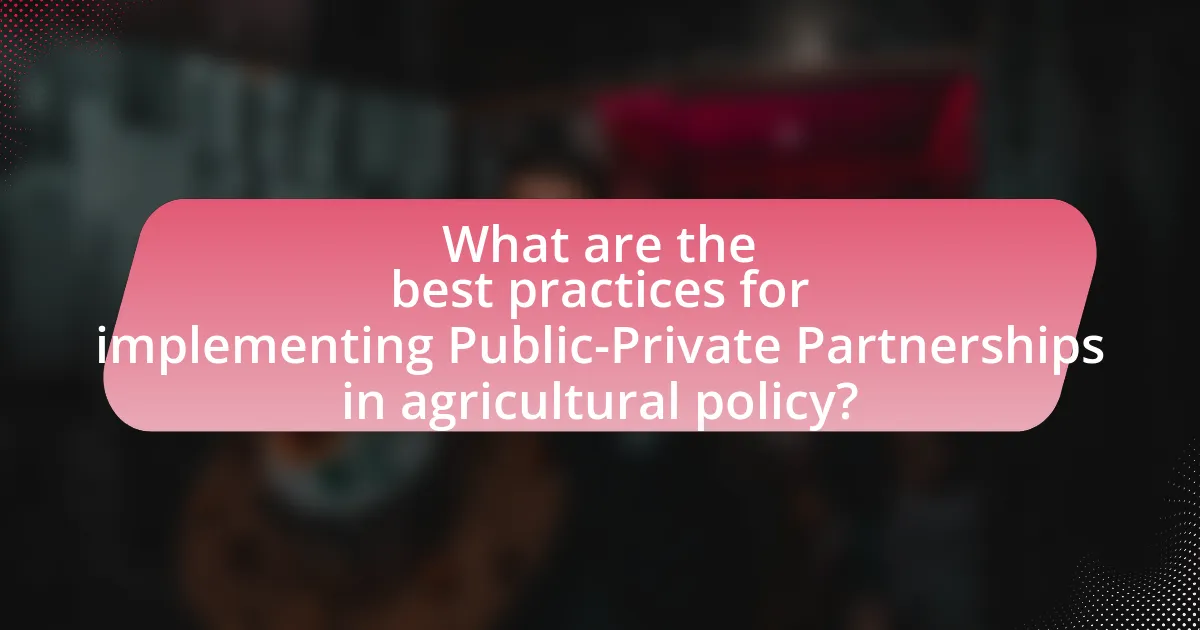
What are the best practices for implementing Public-Private Partnerships in agricultural policy?
The best practices for implementing Public-Private Partnerships (PPPs) in agricultural policy include establishing clear objectives, fostering stakeholder engagement, ensuring transparency, and creating a robust legal framework. Clear objectives guide the partnership’s direction, while stakeholder engagement, including farmers, private companies, and government entities, ensures that diverse perspectives are considered, leading to more effective policies. Transparency in operations and decision-making builds trust among partners and the public, which is crucial for long-term success. A robust legal framework provides the necessary guidelines and protections for all parties involved, facilitating smoother collaboration. Evidence from successful PPPs, such as the partnership between the government of Kenya and private agribusinesses, demonstrates that these practices lead to improved agricultural productivity and sustainability.
What steps should be taken to establish effective Public-Private Partnerships?
To establish effective Public-Private Partnerships (PPPs), stakeholders must first identify common goals and objectives that align the interests of both public and private sectors. This alignment ensures that all parties are working towards a shared vision, which is crucial for collaboration. Next, stakeholders should conduct a thorough assessment of resources, capabilities, and risks associated with the partnership, allowing for informed decision-making and strategic planning.
Additionally, establishing clear governance structures and communication channels is essential to facilitate transparency and accountability throughout the partnership. Regular monitoring and evaluation mechanisms should be implemented to assess progress and adapt strategies as needed, ensuring that the partnership remains effective and responsive to changing circumstances.
Evidence from successful PPPs in agricultural policy development, such as the partnership between the World Bank and local governments in various countries, demonstrates that these steps lead to improved outcomes in resource allocation and project implementation.
How can clear objectives and goals be defined for Public-Private Partnerships?
Clear objectives and goals for Public-Private Partnerships (PPPs) can be defined through a structured framework that includes stakeholder engagement, needs assessment, and measurable outcomes. Stakeholder engagement involves identifying and involving all relevant parties, such as government agencies, private sector entities, and community representatives, to ensure that diverse perspectives are considered. A needs assessment helps to identify specific challenges and opportunities within the agricultural sector, allowing for targeted objectives. Finally, establishing measurable outcomes ensures that the goals are specific, achievable, and can be evaluated over time. For instance, a study by the World Bank highlights that successful PPPs in agriculture often set clear performance indicators, such as increased crop yields or improved access to markets, which facilitate accountability and progress tracking.
What metrics should be used to evaluate the success of Public-Private Partnerships?
The metrics used to evaluate the success of Public-Private Partnerships (PPPs) include financial performance, project delivery timelines, stakeholder satisfaction, and social impact. Financial performance assesses cost-effectiveness and return on investment, while project delivery timelines measure adherence to schedules. Stakeholder satisfaction gauges the perceptions of involved parties, and social impact evaluates the benefits to the community, such as improved agricultural productivity or access to resources. These metrics are essential for determining the overall effectiveness and sustainability of PPPs in agricultural policy development, as evidenced by studies showing that successful partnerships often lead to enhanced resource allocation and increased agricultural outputs.
What lessons can be learned from successful Public-Private Partnerships in agriculture?
Successful Public-Private Partnerships (PPPs) in agriculture demonstrate the importance of collaboration, resource sharing, and innovation in enhancing agricultural productivity and sustainability. These partnerships often lead to improved access to technology and financing, as evidenced by initiatives like the Alliance for a Green Revolution in Africa, which mobilized over $500 million in funding to support smallholder farmers. Additionally, successful PPPs highlight the need for clear governance structures and accountability mechanisms, ensuring that both public and private entities align their goals effectively. For instance, the partnership between the World Bank and various agribusinesses has shown that shared risk and investment can lead to significant advancements in agricultural practices and food security.
What case studies illustrate effective Public-Private Partnerships in agricultural policy?
Case studies illustrating effective Public-Private Partnerships (PPPs) in agricultural policy include the partnership between the International Finance Corporation (IFC) and the government of Kenya, which focused on enhancing the productivity of smallholder farmers through access to finance and technology. This initiative resulted in a 30% increase in crop yields for participating farmers, demonstrating the effectiveness of collaborative efforts in agricultural development. Another example is the collaboration between the World Bank and private agribusiness firms in India, which aimed to improve supply chain efficiency and market access for farmers. This partnership led to a 20% reduction in post-harvest losses, showcasing the tangible benefits of PPPs in agricultural policy.
How can these lessons be applied to future partnerships?
Lessons from public-private partnerships in agricultural policy development can be applied to future partnerships by emphasizing collaboration, transparency, and shared goals. For instance, successful partnerships have demonstrated that aligning objectives between public entities and private stakeholders leads to more effective resource allocation and innovation. A study by the World Bank highlights that partnerships with clear communication channels and mutual accountability mechanisms result in higher project success rates, reinforcing the importance of these elements in future collaborations. By integrating these lessons, future partnerships can enhance their effectiveness and sustainability in addressing agricultural challenges.
What practical tips can enhance the effectiveness of Public-Private Partnerships in agricultural policy development?
To enhance the effectiveness of Public-Private Partnerships (PPPs) in agricultural policy development, stakeholders should prioritize clear communication and shared objectives. Establishing transparent channels for dialogue ensures that both public and private entities align their goals, facilitating collaborative decision-making. Evidence from successful PPPs, such as the partnership between the World Bank and various agricultural firms, demonstrates that shared objectives lead to more effective resource allocation and project outcomes. Additionally, incorporating stakeholder feedback into policy design can improve relevance and acceptance, as seen in the case of the Agricultural Innovation Systems approach, which emphasizes participatory methods.










